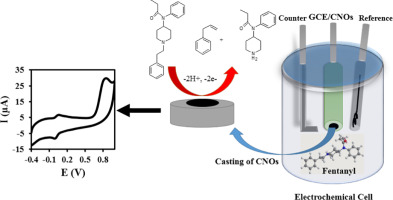Biomaterials Advances ( IF 7.9 ) Pub Date : 2020-01-21 , DOI: 10.1016/j.msec.2020.110684 Esmail Sohouli , Amir Homayoun Keihan , Faezeh Shahdost-fard , Ebrahim Naghian , Marta E. Plonska-Brzezinska , Mehdi Rahimi-Nasrabadi , Farhad Ahmadi

|
Fentanyl is a pain reliever stronger and deadlier than heroin. This lethal drug has killed many people in different countries recently. Due to the importance of the diagnosis of this drug, a fentanyl electrochemical sensor is developed based on a glassy carbon electrode (GCE) modified with the carbon nanoonions (CNOs) in this study. Accordingly, the electrochemical studies indicated the sensor is capable of the voltammetric determination of traces of fentanyl at a working potential of 0.85 (vs. Ag/AgCl). To obtain the great efficiency of the sensor some experimental factors such as time, the potential of accumulation and pH value of the electrolyte were optimized. The results illustrated a reduction and two oxidation peaks for fentanyl in phosphate buffer (PB) with pH = 7.0 under a probable mechanism of electrochemical–chemical–electrochemical (ECE). The differential pulse voltammetry (DPV) currents related to the fentanyl detection were linear with an increase of fentanyl concentrations in a linear range between 1 μM to 60 μM with a detection limit (LOD) of 300 nM. Furthermore, the values of the diffusion coefficient (D), transfer coefficient (α) and catalytic constant rate (kcat) were calculated to be 2.76 × 10−6 cm2 s−1, 0.54 and 1.76 × 104 M−1 s−1, respectively. These satisfactory results may be attributed to utilizing the CNOs in the electrode modification process due to some of its admirable characterizations of this nanostructure including high surface area, excellent electrical conductivity and good electrocatalytic activity. Consequently, these finding points the achieving a simple sensing system to measure of the fentanyl as an important drug from the judicial perspective might be a dream coming true soon.
中文翻译:

碳纳米离子修饰的玻碳电极,用于电化学测定芬太尼
芬太尼是一种比海洛因更强,更致命的止痛药。这种致命的毒品最近在不同国家杀死了许多人。由于诊断这种药物的重要性,在这项研究中,基于用碳纳米离子(CNO)修饰的玻璃碳电极(GCE)开发了芬太尼电化学传感器。因此,电化学研究表明该传感器能够在工作电势为0.85(vs. Ag / AgCl)下伏安法测定痕量的芬太尼。为了获得传感器的高效率,优化了一些实验因素,例如时间,电解液的累积电位和pH值。结果表明在pH = 7的磷酸盐缓冲液(PB)中芬太尼有一个还原峰和两个氧化峰。在电化学-化学-电化学(ECE)的可能机理下为0。与芬太尼检测相关的差分脉冲伏安(DPV)电流呈线性变化,芬太尼浓度在1μM至60μM的线性范围内增加,检测限(LOD)为300 nM。此外,扩散系数的值(d),传热系数(α)和催化恒定的速率(ķ CA吨)分别计算为2.76×10 -6 厘米2 小号-1,0.54和1.76×10 4 中号-1 小号-1,分别。这些令人满意的结果可能归因于CNOs在电极改性过程中的应用,这是由于该纳米结构具有令人钦佩的特性,包括高表面积,出色的电导率和良好的电催化活性。因此,这些发现表明,从司法角度出发,实现一种简单的传感系统来测量作为重要药物的芬太尼可能是一个梦想,即将实现。


























 京公网安备 11010802027423号
京公网安备 11010802027423号